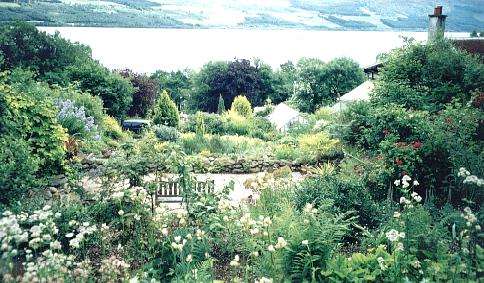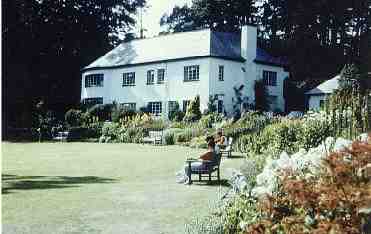|
Go on, Contemplate . . . What do gardeners do at the end of November? Itís piddling down rain, blowing gales, and from the window you can see that the confident staking of the Brussels sprouts was once again wholly inadequate. Itís a wee bit early yet to be browsing the seed catalogues. Thatís a post-Christmas-dinner job. There is a period in early winter, when gardeners are perceived to be idle. And are therefore coerced into unnatural activities like decorating and Christmas shopping. We must unite in our resistance, for this is an important period in a gardenerís life cycle. It is a time of contemplation. It is a time of mulling over the seasonís successes and failures. It is a time of working out how to do better next year. Why can non-gardening partners not understand this period of contemplation? It is vital to next years productivity. Christmas shopping? Bah! Humbug! In little over a month I will be sowing next yearís onions. What could be more important than that? And in the meantime, we must contemplate. We gardeners have only a very short season of respite. And this is the time to think on where we have been and what we have seen. Or where we would like to have been, and what we would like to have seen. Either way is inspiration for another season. When people catch me in my garden at the weekend, they invariably wonder why Iím not inside with my feet up. After all, I do gardens for a living. Sad I may be, but the expression ďbusmanís holidayĒ was invented for yours truly. When I get a wee break, I head for gardens. And every garden I visit, provides me with some inspiration for either my own or my clientsí gardens. One of my favourites is Abriachan Gardens and Nursery on the shores of Loch Ness. Every time I visit, it has expanded a wee bit further up the hill. The plant collections are wonderful, and the views equally so. In these days of commercial garden centres stocking only those plants which the wholesalers decide to promote, it is so refreshing to find a retail nursery run by plant people, who grow and propagate their own stock. If you are into herbaceous plants, you will be in heaven. And if you like Rhododendrons, the prices are such that I advise you to hire a van to go on your hols.
Of course, coming from Caithness, youíll have to pass through Inverness to get to Abriachan. So please allow time to visit the Floral Hall at Bughts Park. On a cold winters day (especially as a break from the Christmas shopping, although we all know that real people shop locally, and only aliens descend on Inverness for Christmas), the subtropical greenhouses, with the waterfall and fishpond, and more importantly to me, the diversity of subtropical plants, are an absolute haven. The cactus house is something else, rivalling the Duthie Park Winter Gardens in Aberdeen. The mirror on the lower floor is intended to have an enlarging effect on the display, but for the crafty photographer, it is a great opportunity to get self in shot. Without the hassle of a self-timer. Or a patient friend. So long as you have no hair, or a centre parting. If you have no friends close enough to spot a mirror image, youíre even sadder than me.
The Floral Hall has a damn good coffee shop, too. Shame its opening hours are so restricted. But thatís tourism in Scotland for you. We have a short season, but still Scotland closes at 4.30. (Except for the Tourist Info Centres, some of which donít appear to open at all) So the best thing you can do, as a tourist, is drive from Inverness overnight, and hit Inverewe Gardens when it opens at 9.30am. In season.
Now I have a great respect for the NTS, and without them, our heritage would be at best poorer, and at worst bulldozed. But some of their properties are a bit overpriced. I donít grudge the entrance charge to the gardens, because the gardens are fantastic, and the history behind them is inspirational. But my advice is, take a Thermos. The marketing people of the NTS have obviously sussed that the average punter, having busted a gut hiking round the (albeit beautiful) gardens, and recognising that even nowhere is miles away from here, will thankfully swap the equivalent of a vital organ on the black market for a mere cup of coffee. With Thermos in hand, donít let the coffee shop or the other hard-sell, embarrassingly profiteering, NTS promos bother you too much. (They have an excellent selection of books, all of which you can buy for much less at your local bookshop, or on-line) Walk in these wonderful gardens, though. Osgood McKenzie was born in 1842. His father, Sir Francis, was laird of Gairloch. Young Osgood was only twenty when he inherited Gairloch Estate, and consequently, Inverewe. He was either blessed with amazing foresight or cursed with incredible stupidity, for he chose to build himself a house on a barren, rocky and exposed promontory on the shores of Loch Ewe. History would support the former. When you consider that Inverewe is about the same latitude as Hudsonís Bay, Canada, and further north than Moscow, you begin to understand that Osgoodís concept of creating a garden was treated with a little derision. Local crofters assured him he wouldnít even grow neeps. And as those of us familiar with neeps will tell you, that was scathing criticism indeed. But Osgood McKenzie was blessed with one thing which set him apart. Vision, and the concept of time. And if thatís two things, I apologise - Iím getting carried away here. Osgood was ahead of his time, and was aware that Scotlandís north-west shores were warmed by Atlantic currents from the Carribean. Frosts were almost unheard of. The big problem was salt laden winds, which burned and shrivelled any leafy plant growth. He planted salt tolerant pines, both native and Scandinavian. He had the patience to allow them to grow. Then he reclaimed areas of the seashore, according to rumour with soil imported from Ireland. If thatís true, he must have been worth a few bob. Other accounts, which for me are more plausible, suggest the foreshore was reclaimed with a mixture of peat from the surrounding bogs, and seaweed from the shore. Fertility being improved by the local crofters. Or rather their livestock. Anyway, to cut a drearily meandering story short-ish, by the end of the 19th century, Osgood had created not only the necessary shelter, but also one of the finest collections of temperate plants in Scotland, if not the UK. Romping rapidly through the history, Osgoodís daughter Mairi took over the garden when her father died in 1922. She continued to care for the garden, and first opened it to the public during the Second World War. Before she died in 1953, she had arranged for it to be taken over by the National Trust for Scotland, and to this day it remains the jewel in the NTS crown. Now some meaty stuff for plant-o-philes. Inverewe hosts national collections of (barbata subsection) Rhododendrons, Ourisisia, Olearia, and Brachyglottis. It is also home to a wide range of unusual plants from Tasmania, New Zealand and Australia, including a wonderful collection of Eucalyptus.. An impressive range of plants from China, Japan, Tibet and South America are also found to nestle among some native Scots flora. And you really must see the bamboo! But most of all, you have to be there in May or June, when the Rhodys are out. Listen to Mike. This is colour to die for. Sorry, I got a bit carried away there. But this is case in point. At the back end of the year, you canít do anything in the garden without doing more harm than good. So dream. Dream of the places you have been. The gardens you have seen. The gardens you would like to see. Take inspiration. Use that inspiration, and start planning for next year. © Mike Clark 2002. |


